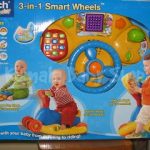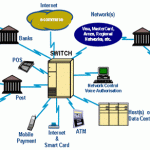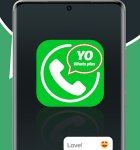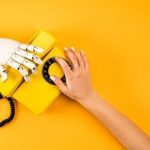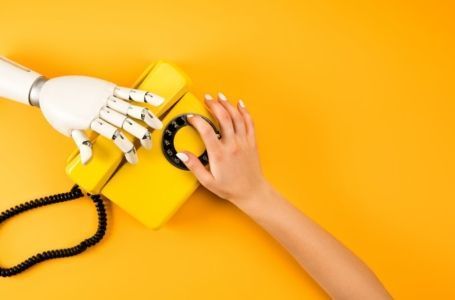
Click&collect – engage the customer in an interaction with the brand
In the era of dynamically changing consumer preferences, the legitimacy of the fight for the customer’s attention is lost. Between stationary stores and online competition. With the proper use of mobile technologies, it is possible to provide the customer with a comfortable shopping path in almost every industry, combining online and offline experiences. This is proven by the growing trend of the click model&collect, which is being adopted by an increasing number of retailers.
Where your customer is?
Today’s consumer is never offline. Having their phone with them 24 hours a day, they respond flexibly to emerging purchase needs and consciously choose those sales channels they find most convenient. The challenge is to adjust the strategy of reaching out to the customer in such a way as to give him/her the greatest possible number of points of contact with the brand – not only in the online environment.
A multi-channel approach to sales, however, must involve more than just the availability of online stores on par with stationary stores. It is also a technological challenge to make the customer journey a convenient and tailor-made experience. It can be met both by mobile applications and by tight integration of online and traditional sales.
Order online, pick up offline
Even if we still make extensive use of stationary stores, our decisions are increasingly based on previous price comparisons or searching for product reviews online. Regardless of whether we are guided by the ROPO principle (research online, purchase offline) or its inverse, on our path to purchase we take at least some steps in the online space.
The method of delivery and collection of products should therefore meet the requirements of the multichannel customer. Simply offering parcel delivery, even if free of charge, does not fully support this concept. Hence the growing popularity of the click method&collect, i.e. ordering online with personal collection. It allows the customer to complete the order at home, without having to wander the aisles of the store, and then pick up the ordered products at a chosen place and time.
How does click work?&collect?
Click model&collect is most often realized in 3 ways:
– collection in a stationary store;
– collection at a partner store;
– pick up in a parcel machine.
This is a solution that reconciles the convenience of buying online, with the offline experience of the product or brand. Makes the customer independent from waiting for delivery and gives them almost full decision-making power on how to pick up the ordered products.
Until recently, this method was chosen mainly because of cheaper delivery costs or more flexible pick-up logistics. The coronavirus pandemic, however, has made us increasingly willing to use this option even after traditional commerce has resumed. The BOPIS model (buy online, pickup in store) has begun to be invested in by representatives of industries, which turned out to be late comers to the market of online services.
A model for the e-commerce boom
With the popularization of daily online shopping, representatives of many industries (especially FMCG) decided to offer the click&collect for your customers. It has been implemented by such brands as IKEA, Kaufland, Lidl or CirleK, which offer to collect pre-ordered products in specially designated places.
Popularization of this approach in the long run may mean the emergence of another contact point with the brand – the Internet order pick-up point. It has the potential to become a permanent stop on our shopping journey. What’s more, it can take many forms:
– a specially designated place in the store;
– separate checkout for order processing c&C;
– parcel or fridge machine;
– collection at the parking lot with an option of delivery by a store assistant (curb side pickup).
Mobile solutions should play a key role in all of these models, supporting the user’s journey and guiding them from order placement to collection. The most common mistake stores make is directing the customer c&c to a standard cash register – the idea of the BOPIS model then loses its sense.
How to put the reins in the hands of the customer?
It is enough to engage him in the order process, and thus in a subconscious interaction with the brand. Appropriate use of mobile technologies will significantly enhance the shopping experience and make the customer an active participant in the entire process.
Offering the customer an app will allow them to:
– keep track of the process of preparing or shipping an order;
– report any problems with the pick-up or get in touch about their order;
– pick up your order with the support of mobile solutions, e.g. by scanning a QR code, using geolocation, etc.
Aligning the process with the brand’s main objectives will ensure that the customer feels taken care of at all stages of the ordering process. This will engage them in more frequent interactions with the brand, as well as make them more likely to refer e.g. to the stationary store. This, in turn, can translate into effective use of crosseling strategies.
How the biggest ones do it?
Although the option to reserve goods in-store has been operating effectively in Poland for some time – e.g. in the area of consumer electronics or household appliances, recently many brands have efficiently responded to the growing trend of online retail. introduction of click&collect in more stores than ever before was a natural response to the emerging pandemic.
Reservation of products with the possibility of pick-up and payment in the store is offered by m.in. Lidl, Żabka or Stokrotka, although the service often works only in selected locations. Auchan offers the possibility of completing one’s own order or choosing from ready-made sets, and Kaufland is currently testing the service as a pilot, offering customers a choice from a limited pool of 1500 products.
Decathlon offers the option of collecting purchases without leaving the car, while IKEA does not rule out that pick-up points, which are currently being built mainly at its stores, will also be possible in the future in new, more diversified locations.
Brands also like to use the support of such companies as Uber, Bolt or InPost. The latter is a great example of a well-designed and user-friendly mobile app that is a natural extension of the user’s shopping experience.
Engagement that pays off
As the above examples show, the key elements of the implementation of the click&collect should be first and foremost, a well thought-out order processing system, as well as matching solutions to the customer profile.
Proper integration of technological solutions offered in the click model is extremely important&collect with the store’s existing IT infrastructure. It is therefore worth considering establishing cooperation with an experienced partner who is able to support the project at all stages – from the logistics process, through connection with ERP, to implementation of the website or mobile application.
At New Gravity, we are currently conducting several implementations of click&collect and we have a lot of valuable experience that can help in planning such a project.

